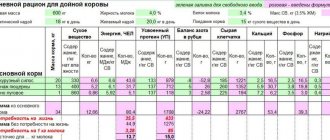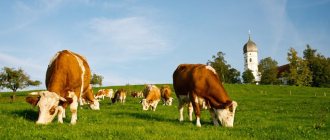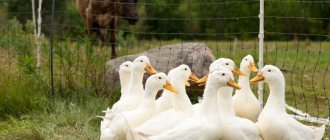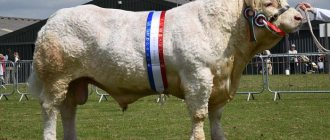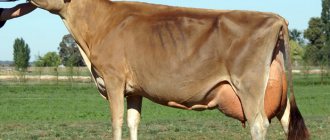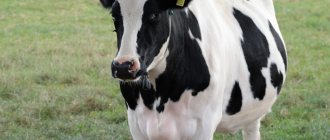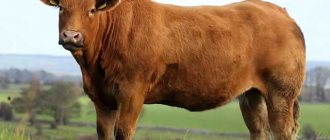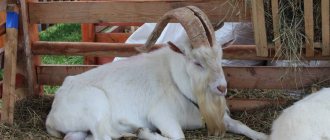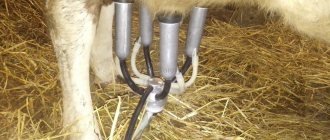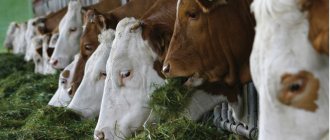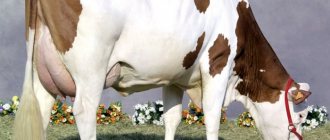published: 18. 12 . 2019
author: Vitaly Shibarshin
From this article you will learn:
- What are the types of cow feed?
- What are the features of feeding cows in summer?
- What should a cow's feeding diet consist of during the winter?
- What should a dairy cow's diet be like?
- How to create a diet for a beef cow
- What to consider when planning a diet for a pregnant cow
- How to feed young animals correctly
- What causes cow diseases and how to prevent it
- Is there any benefit to feeding cows the same way?
- Why is glucose good for feeding cows?
- What rules should you follow when preparing the correct diet for feeding cows?
Balanced feeding of cattle is the main condition for its high productivity. The diet of cows, enriched with minerals and nutrients, helps to increase milk production, improve the quality of milk and meat, and reduce the level of disease in animals. Therefore, to obtain high returns, it is very important to be able to organize complete feeding, correctly calculate the portion and introduce new components into it in a timely manner. You will learn how to do this from this article.
Basics of proper diet for cows in summer and winter
The main diet of cows of all ages and breeds (except newborn calves) consists of green and hay masses. Other types of food are complementary foods.
Diet of cows in summer
Summer is called grazing season for cattle. The diet of cows in the summer consists of green feed. Farmers organize daily stay of animals on pastures. On pastures, cows receive a sufficient amount of all the necessary green feed, and return home only at night to receive a portion of complementary food and spend the night.
There is another way of feeding - the farmer independently prepares green food for animals. But since one adult animal can eat up to 70 kg of such food per day, this method is a more expensive technology.
In the summer months, the diet of cows is supplemented with complementary foods, which include:
- seasonal vegetables and root vegetables;
- melons;
- feed;
- vegetable tops;
- food waste.
Diet of a cow in winter
The main diet of cows in winter consists of dry feed - hay and straw. To ensure adequate feeding, animals are additionally given root crops, silage, and mixed feed. Farmers produce hay themselves or purchase it from suppliers. One adult cow eats up to 15–20 kg of dry food per day.
Important! When purchasing hay, you need to check its quality. To do this, it is recommended to take a sample from under the upper layers of a bale or stack, carefully examine for the presence of diaper rash, pay attention to the composition, color, and smell. It is better to purchase dry food from trusted and conscientious suppliers.
In winter, the cow's daily diet consists of roughage. Therefore, when feeding, it is important that the basis of daily portions consists of quality hay and grass cuttings. Bulky and coarse hay of low quality is difficult to digest. Dairy cows can consume it in sufficient quantities when dry. The presence of 1.5–2 kg of low-grade hay per 100 kg of dry food is acceptable.
High-grade quality hay is beneficial for cattle. It contains a lot of proteins, minerals and vitamins.
A cow's daily diet must contain feed additives: root crops, silage, melons. Among root vegetables, the most suitable as complementary foods are: sugar and semi-sugar beets, potato tubers, and carotene-rich red carrots.
The volume of succulent feed additives in a cow’s daily diet must be gradually increased to a ratio of 10 kg (or higher) per 100 kg of high-grade hay weight. For pregnant dry animals, the increase is up to 4-5 kg per day of succulent agricultural products.
To ensure adequate nutrition for cattle, concentrates or complete feed are included in the daily ration. With normal milk yield their share is 300–350 g per 1 kg of milk, and with high milk yield it is increased to 500 g per 1 kg of milk. For better feeding of the cow, fish meal is added at a rate of 300–500 g per day.
Crude fiber
Proper feeding of cows requires sufficient feed structure. It creates the basis for healthy rumen function and is essential for ensuring large amounts of feed are eaten, gastrointestinal motility and the digestive process. Cows must be fed feed with a balanced structure.
One of the indicators characterizing the structure of feed is crude fiber .
For example, crude fiber should be at least 17% of the dry matter of the diet for dairy cows in the first third of lactation. It is this indicator that we will focus on when calculating our diet.
Our cow eats 15 kg of dry matter per day, which means the crude fiber indicator should be at least 15 kg x 17% / 100% = 2.55 kg or 2550 g
In addition to crude fiber, the structure of the diet is indicated by such indicators as the amount of neutral detergent fiber, acid detergent fiber and acid detergent lignin in the feed.
In Germany, they also use the feed structure indicator (a number that allows one to compare the effect of the structure of different feeds or the overall diet).
Diet of a dairy cow
Preparing the correct diet for a cow can be a bit challenging. In order to correctly calculate the required amount of feed, you need to take into account all the details and make certain adjustments.
To calculate a cow's daily diet, we first take the average food consumption standards for one cow per day. Then the average statistical indicator must be adjusted. The menu and amount of feed directly depends on the milk supply of the cow (milk or dry), the breed of the animal (meat or dairy), its physical characteristics: weight, age and general condition.
Basic moments
The diet of dairy cows differs significantly from the feeding standards of beef cattle. Do not forget that the amount of milk yield and its dynamics directly depends on the type and quality of feed that the animal consumes. For dairy herds, the menu must include succulent milk feeds:
- fresh grass;
- root vegetables: carrots, beets, Jerusalem artichoke;
- vegetables: pumpkin, squash.
To increase milk yield, in addition to succulent milk feed, it is important to provide the necessary drinking regime for the cow. The volume of water for a dairy cow in winter is 35–40 liters; the animal can drink up to 15 times a day. At the same time, a dry cow consumes water up to five times a day in a volume of 12–15 liters.
For a farmer, it is important not only the quantity of milk received from one cow, but also its quality. To increase the quality indicators of dairy products, grain and its derivatives, as well as special feed additives enriched with vitamins, are additionally introduced into the diet of a dairy cow.
Before you begin to compile a diet for a dairy cow, you need to clearly divide all the animals in the herd into groups. One category includes individuals that have approximately the same physical indicators: weight, age and general condition. We must not forget that the amount of feed required for each dairy cow should be calculated taking into account its daily milk yield.
Beef cow diet
The diet of beef cows is structured differently. Cattle of beef breeds are kept in a free-stall manner. With this content there are no restrictions on the consumption of green and roughage. To feed animals, special fattening technologies are used using silage, green feed, pulp, stillage and various feed mixtures.
The basis of the diet of beef cows is green grass and hay obtained from pastures and pastures.
As an addition, the menu includes root vegetables, seasonal vegetables and fruits, feed and concentrates. To obtain marbled beef and fatten livestock to the required standards, the daily diet of cows is supplemented with combined products: grain crops, cake, bran, meal, meat-bone and fish meal. One animal consumes up to 400 g of combined feed per day.
Although compound feed increases the meat productivity of cattle, it is not recommended to include more than 400 g of such feed per day in a cow’s diet. Excessive consumption of combined feeds by animals leads to digestive disorders.
- If cattle are kept for fattening in a stall on a leash, then feeding is carried out 2-3 times a day, at equal time intervals.
- The most cost-effective technology for fattening cattle is fattening on pasture. But this method is used mainly in the warm season and is most common in areas where there is a good food supply: in the Voronezh and Rostov regions, Stavropol and Krasnodar territories.
Both methods described above are well suited for fattening animals. The choice of feeding option for beef cows depends on the conditions of their keeping and the capabilities of the farmer. But in any case, the main component in the diet of beef cattle is combined feed rich in proteins. They promote rapid weight gain.
- Beef cows must graze for at least 12-13 hours a day.
Scientists from the Astrakhan region have proven through experimental research that better fattening results can be achieved if you increase the grazing time by at least two hours. Especially at the beginning of the season, in May and June. The most significant result of weight gain is 2 kg per day, and the total weight gain per head of cattle was 40% and 70% in young animals.
Sometimes cows begin to “gnaw” their feeders or chew manure. This comes from a lack of minerals in the diet. Green food does not contain enough minerals necessary for animal life. Therefore, a cow’s daily diet should include at least 40 g of mineral feed containing 15 g of calcium, 12 g of phosphorus, and 13 g of table salt. Moreover, the amount of salt during the summer should gradually increase to 2 kg. They leave it in various places in the pen.
- Particular attention should be paid to the watering hole.
Although one cow on grazing along with grass receives from 35 to 40 liters of water per day, in order to fully satisfy the animals’ need for water, it is necessary to ensure an optimal drinking regime - water at least three times a day.
- The process of fattening beef cows is divided into two stages depending on the age of the animal: the first stage lasts from 1 to 6 months, the second stage - from 6 months and older.
Up to six months, the diet of young animals of both sexes (bulls and heifers) is no different, and weight gain is at the same level. After 6 months, the bulls and heifers are separated from each other.
Adult, mature animals need 80 g of protein per feed unit. But to ensure the desired results of fattening beef cows, it is better to be guided by the standards presented in the table. Recommended values for preparing the diet for stalled cows in the winter:
The table shows average data that can be used to create the correct diet for fattening cows. To achieve better results, it is recommended to add 500 g of concentrates or 700–800 g of molasses to animal food once a day.
In the warm season, the basis of the cattle diet is fresh grass. This allows you to reduce the consumption of root crops and vegetables, which serve as a source of nutrients and vitamins in the winter and are added to the diet of cows in large quantities. Keeping a beef cow on pasture will cost the farmer much less.
But it is not always possible to provide grazing for a cow even in summer. If an animal is kept in a stall during the warm season, then the basis of its diet is cut green grass, which is placed in a feeder. In this case, green food makes up at least 50–70% of the total daily intake.
Increased efficiency
There are two methods for monitoring the quality of feeding on farms - zootechnical and physiological; let's look at them using the example of an unbalanced diet.
The most common manifestation is ketosis. The disease is caused by a violation of fat, protein and carbohydrate metabolism.
The main causes of improper metabolism are:
- malnutrition;
- improper use of feed;
- insufficient carbohydrate content;
- too much silage;
- poor quality haylage.
The accompanying reason is hidden in the violation of hygienic conditions of detention.
Propionic acid is a warning factor for ketosis. This is a source of glucose that reduces the development of negative microflora in the cow’s gastric system. It is formed in the forestomach due to eating large amounts of concentrates and good hay.
How to feed a cow to improve feed absorption processes? Vegetable bitterness should appear in the animal’s gastrointestinal tract (physiological method). They are divided into aromatic and pure.
But for therapeutic purposes, both are used as taste irritants. They reflexively act on the animal through nerve cells, increasing the secretion of gastric juice. Fermentation activates digestion and appetite.
Vegetable bitters include:
- gentian (root);
- dandelion (root);
- trefoil (leaves).
Aromatic - calamus, wormwood, yarrow. Close to them are dill, cumin, anise. Regular salt is considered a good way to improve cow digestion.
Zootechnical methods for preventing ketosis include:
- systematically maintaining cleanliness in the feeders;
- free access to clean drinking water;
- a sufficient amount of good quality food.
Straw with mold, spoiled silage, good-quality haylage and sour pulp are unsuitable for feeding to highly productive cows. Overfeeding of certain types of food also has a bad effect on animals. For example, long-term feeding of the same type, silage or concentrate is undesirable.
The decline in lactation of a highly productive cow can also be caused by a lack of quality hay.
Therefore, it is important to monitor what and how much a cow eats per day. It is necessary to carry out a gradual change of feed and rations depending on the season. The transition period from housing to grazing should be at least two weeks. Changing food types, for example, from concentrated to bulky, should take 4-6 weeks.
Diet of pregnant cows
The calf's health directly depends on the diet of pregnant cows. It is necessary to carefully think through all the components of the cow’s nutrition from the very beginning of pregnancy. It is very important that the animal, along with food, receives all the nutrients and vitamins necessary to maintain the normal condition of the cow itself and the development of its fetus.
- What should a pregnant cow's diet be like?
The diet of a pregnant cow should include highly nutritious foods that are easily digested by the body: bean hay, succulent feed (silage, root crops, grass), concentrates in small quantities.
Tip: It is very useful to include sugar beets in moderate quantities in the diet of pregnant cows. This root vegetable is added to feed to prevent udder diseases after calving.
Do not forget that during pregnancy a cow needs minerals, which are contained in bone meal, chalk, limestone, and table salt.
In the winter season, a pregnant cow requires food enriched with nutritional supplements and vitamins. Fish oil, feed yeast, and special vitamins should be added to the feed. In order to balance the main components of nutrients and protein, it is necessary to introduce bran and cake into the animal’s diet.
- How much feed to give to a pregnant cow?
The daily volume of feed for one pregnant cow is calculated in accordance with its body weight. The average daily intake is: 2-2.5 kg of roughage and 4-5 kg of succulent feed.
Various food additives and mineral supplements supplement the cow’s diet depending on its general physical condition and time of year. In winter, when green feed is reduced or absent, it is necessary to increase the amount of supplements.
- What is included in the diet of a pregnant cow?
At the very beginning of pregnancy, the cow's diet is varied, containing all types of feed. But over time, the diet changes.
The proportion of succulent feeds is gradually decreasing, being replaced with roughage and wet mash. To maintain the health of the cow, it is necessary to carefully monitor its condition and weight. Loss of body weight indicates complications that have arisen.
A cow's diet changes after calving. The feeding regimen and the amount of food consumed becomes normal. Sometimes, in order to activate the process of milk formation, the method of advanced nutrition is used.
Diet of young animals
In order for the calf to develop strong immunity and grow strong and healthy, it is necessary to feed the newborn with colostrum in the first hours of life. Over the next three days, the calf's diet consists of mother's milk, which is given at least six times a day. After this three-day period, the milk dosage is reduced to two liters, and the number of feedings is reduced to three times a day. This regime lasts for up to three weeks. After this time, the milk can be replaced with reverse milk, and the calf begins to be accustomed to “adult” feed. He is fed hay, grass, mash and mash based on skim milk and bran.
It is recommended to reverse feed dairy heifers for up to two months.
What causes cow diseases and how to prevent it
Academician V. Levchenko suggested that due to non-compliance with feeding standards, lack of starch and sugar in the diet of cows, an energy deficiency occurs. This leads to the development of multiple pathologies in cattle: rumen hypotension, hepatodystrophy, acidosis, ketosis.
Diseases often develop against the background of a diet that is oversaturated with proteins.
Proteins in the body of cattle are hydrolyzed by rumen microorganisms. Excessive amounts of butyric acid provoke problems and diseases in animals. The processes occurring in the forestomach of a cow contribute to the development of various diseases.
Soy protein is broken down very slowly in the body, so in a cow's rumen its breakdown period lasts a very long time. More healthy soybean meal is introduced into the diet of highly productive cows along with feed; its ratio is 1.5–2.0% of the total daily requirement. In terms of the duration of the splitting period, sunflower protein ranks second. In the shortest period of time, rapeseed protein breaks down. A balanced ratio of these three protein sources helps optimize the nitrogen balance in cattle.
When preparing a diet for cows, we must not forget about the mineral basis of cattle feed.
A large amount of minerals are excreted from the body of dairy cows every day along with milk.
In order for the animal’s body to be saturated with minerals in the required quantity, it is necessary to carefully control their share in the diet. A deficiency or excess of these nutrients in cattle nutrition negatively affects the absorption of important microelements.
Pathological risk factors and causes of disease development in highly productive cows:
- an excess of calcium in the diet of cows leads to a deterioration in the absorption of vital elements: copper, zinc, iodine;
- when an animal’s body is oversaturated with magnesium, calcium absorption decreases;
- lack of phosphorus leads to severe damage to the ovaries and causes infertility in female cattle;
- excess iron interferes with the absorption of zinc and leads to copper deficiency;
- if there is a lack of zinc in the diet of cows, the embryo does not take root in the uterus;
- with a lack of such important microelements as cobalt, manganese, copper, highly productive cows have a reduced ability to fertilize.
A properly formulated and balanced diet for cows ensures a regular supply of minerals, proteins, carotene and other biologically significant elements to the animal’s body. Only high-quality feed (hay, silage) contains all the necessary nutrients and microelements.
Is there any benefit to feeding cows the same type of diet?
Recently, Russian farmers have become widespread in the same type of feeding (mono-feeding) of dairy animals - the diet of cows remains the same throughout the year and does not depend on the season. To obtain high gains when organizing cattle nutrition using the same technology, you must adhere to the following rules:
- Corn, clover and other forage crops must be sown in large areas as early as possible.
- During the summer months, dairy cows should only be out grazing until lunchtime.
- In order for milk yield to increase, it is necessary to create stable conditions for animals with a constant diet.
It should be noted that the same type of cattle feeding technology does not contribute to achieving record milk yields. This diet for cows can be called anti-stress, since there is no sudden change in feed of different types, and productivity indicators remain constant throughout the year.
Monofeeding requires the obligatory inclusion of legumes and cereal-legume mixtures in the diet of cows, but it is not recommended to feed cattle too abundantly with sainfoin hay or plants of the legume family. It is better to associate them with silage. The daily diet of cows must include healthy vitamin supplements, feed mixtures and biologically significant microelements.
Some farmers who practice uniform feeding note that this technology does not allow using all the capabilities of highly productive cows. Obtaining high milk yields is facilitated by alternating winter and summer diets in accordance with specially developed schemes.
In regions where there is not enough pasture, cattle are kept in stalls year-round. This regimen is identical to the same type of feeding and is reflected in the level of lactation.
Pasture maintenance ensures a balanced diet for cows, high quality dairy products, and prevention of animal diseases. But in the absence of the necessary conditions for grazing livestock, monofeeding is considered an acceptable option.
Specifics of hay harvesting
The quality of dry grass harvested for the winter depends on the correct organization of haymaking:
- High-quality hay will be obtained if it is harvested early in the growing season. Young grasses are more nutritious, as they differ in foliage. The leaves account for 40-50% of vitamins and other microelements.
- Old plants have fewer leaves, their digestibility decreases, and more waste remains.
The grass cover changes very quickly. For each haymaking option, there are optimal harvest times. For leguminous grasses, this is the onset of budding, and for cereals, this is the beginning of the appearance of an ear. With flowering comes a transition period. Harvesting results in low nutrient content in the hay.
The determining factor for choosing the time is dry and clear weather. When there is rain or dew, the drying of the hay increases, which also leads to loss of nutrients.
Tedding helps reduce the moisture content of hay. There are special mechanical roller rakes for the job.
The color of the hay indicates its quality. It is believed that properly dried grass is green. However, the shades may be different:
- cereals - gray greens;
- sour herbs - intense greens;
- legumes - brown greens;
- Alfalfa is a vibrant green.
If the technological conditions for mowing and storing are violated, the hay will:
- whitish (lying in the sun for a long time);
- light yellow (caught in the rain);
- dark yellow or brown (rotten hay).
Why is glucose good for feeding cows?
Glucose is an irreplaceable source of energy. It plays a key role in the carbohydrate nutrition of cattle, especially lactating cows - it provides the body with energy and a substrate for the synthesis of milk fat. The highest glucose content is in concentrated feed, root vegetables, and fruits. Weakened animals with severe exhaustion and lack of energy are given intravenous and subcutaneous injections of a five percent glucose solution.
In one day, the animal’s body produces from 4 to 6 kg of glucose. To ensure its synthesis, feed should be present in the diet of cows, at least 70% of the total volume of nutrients.
- Recommended reading:
- Lysozyme enzyme: features, purpose, tips for use in animal husbandry
- Vitamin B12 for animals: its significance and methods of administration to the body
- Proper feeding of cattle
Feed classification
All food is divided into several types, depending on their origin. They are:
- vegetable;
- synthesized;
- feed;
- vitamins;
- mineral.
Each of these varieties saturates the animal’s body with a certain amount of energy. To avoid confusion regarding nutritional value, 1 kg of medium-quality oats is taken as the main feed unit (FU). Taking into account these standards, feed comes in bulk, containing 0.6 kg of KE, which can be processed in the cow’s body. Concentrates have a higher KE.
Cows eat mainly plant foods, which are:
- juicy;
- rude;
- concentrated.
Fortified supplements, synthesized using special technologies, help replenish the missing beneficial elements in the body of cows. In addition, they are used when it is necessary to preserve livestock in certain situations. It is useful to give such supplements to animals during pregnancy, during exhaustion, as well as to young animals. Compound feeds are produced from plant components.
When compiling a diet for cows, you need to consider some points:
- level of fat content of dairy products;
- volume of actual and desired milk production (measured in kg/day);
- it is necessary to take into account the lactation period;
- The portion is calculated as follows: 1 KE per 100 kg of individual body weight.
